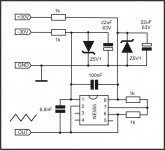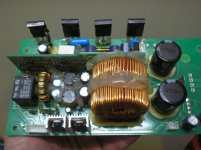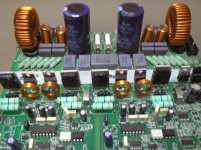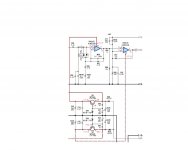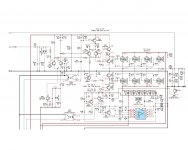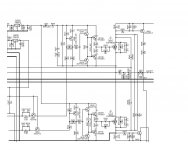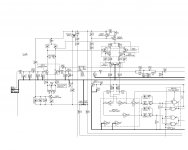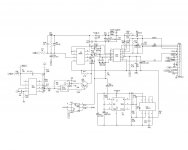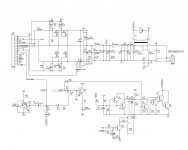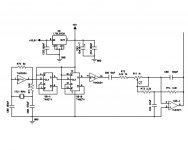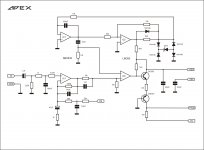Feedback is only for DC servo on this amp.
Thats a smart move as the DC can move around a bit until the amp warms up.
I did a similar project using a TL082 triangle wave generator, LM319 comparator, XOR gates phass splitter and IR2113 mosfet driver.
I didnt use any feedback at all yet it sounded great.
The only minor problem I found was I needed to null the DC offset using a pot or i got low level hum. Must have been an inaccuracy somewhere in the line.
If you don't use any feedback, PSRR becomes 0dB. Ripple from supply rails appears directly at the ouput.
This JBL class D amp for subwoofer can be made without SMD parts.
have you try this amps?
what is the supply voltage?
Regards
have you try this amps?
what is the supply voltage?
Regards
No, but JBL any many other brands use this class D module in active subwoofers...,
Regards
Perhaps the regulated power supply of the Linn power amp model "Klout" is helpful (have a look to the attachement).If you don't use any feedback, PSRR becomes 0dB. Ripple from supply rails appears directly at the ouput.
here a German supplier:LM566 VCO seems unobtainable.
SE566H A15/2475 - SH-Halbleiter Electronic Vertrieb GmbH
According the internal - not too complicated circuit - go to the datasheets about
http://www.datasheetcatalog.org/datasheets/166/53609_DS.pdf
and
NE566N datasheet pdf datenblatt - NXP Semiconductors - Function generator ::: ALLDATASHEET :::
it must be easy possible to create the wanted functions with discrete decices.
Attachments
Last edited:
Perhaps the regulated power supply of the Linn power amp model "Klout" is helpful (have a look to the attachement).
here a German supplier:
SE566H A15/2475 - SH-Halbleiter Electronic Vertrieb GmbH
According the internal - not too complicated circuit - go to the datasheets about
http://www.datasheetcatalog.org/datasheets/166/53609_DS.pdf
and
NE566N datasheet pdf datenblatt - NXP Semiconductors - Function generator ::: ALLDATASHEET :::
it must be easy possible to create the wanted functions with discrete decices.
Or ICL8038 ICL8038
Detailed Schematic page 4
I understand this. The reason is the unknown time of availability. Most Class-D IC's in currently day's are obsolete and no longer available after very few years.I dont't understand why someone will make a 25w discrete class d amplifier, apart from learning. There are many integrated circuits with better performance.
Otherwise brands like B&O (ICEPOWER), Hypex (UCD) and several others
would prefer monolithic IC's instead discrete solutions.
An second reason could be the possibility of detail improvements while the current production.
Last edited:
Icepower and Hypex make discrete amplifiers because they want to achieve higher power and lower distortions than those of the integrated circuits. And they don't make with lm393 and irf530
This schematic have low power and high distortions because of that parts, feedback topology and bad pcb layout. It has poorer performance than most integrated circuits. And is more difficult to make Only drawbacks, for what?
You are right about that some integrated circuits get obsolete, but we talk there from the point of view of a diyer. If some integrated circuit will get obsolete, we can simply pick another ic for our amplifier project. We don't have to modify our production line.
JBL and others use something like that in some products because were designed many years back. In those years that was the level of class d and they didn't have many integrated circuits.In 2011 , this schematic is a shame for class d.
Anyway, if you want to make a discrete amp,is better to make something like um10155 or with irs2092. For those you find a good pcb layout in the application notes. Theese have low distortions and can be scaled for higher power. You will get way better performance than this junk.
This schematic have low power and high distortions because of that parts, feedback topology and bad pcb layout. It has poorer performance than most integrated circuits. And is more difficult to make Only drawbacks, for what?
You are right about that some integrated circuits get obsolete, but we talk there from the point of view of a diyer. If some integrated circuit will get obsolete, we can simply pick another ic for our amplifier project. We don't have to modify our production line.
JBL and others use something like that in some products because were designed many years back. In those years that was the level of class d and they didn't have many integrated circuits.In 2011 , this schematic is a shame for class d.
Anyway, if you want to make a discrete amp,is better to make something like um10155 or with irs2092. For those you find a good pcb layout in the application notes. Theese have low distortions and can be scaled for higher power. You will get way better performance than this junk.
Last edited:
TDA7492 and TDA7498 (ST)
I guess, this both IC models from SGS-Thomson are available for a long time:
TDA7492
http://www.st.com/internet/com/TECHNICAL_RESOURCES/TECHNICAL_LITERATURE/DATASHEET/CD00244535.pdf
http://www.diyaudio.com/forums/clas...tests-hifimediy-t2-ljm-l20d-sure-tda7498.html
TDA7498
http://www.st.com/internet/com/TECHNICAL_RESOURCES/TECHNICAL_LITERATURE/DATASHEET/CD00205863.pdf
http://www.diyaudio.com/forums/class-d/194413-sure-electronics-new-low-cost-25w-100w-board.html
SMSL SA-50 - Verstärker, Lautsprecher, Zubehör - Analog-Forum
http://www.intersil.com/data/fn/fn2864.pdf
I guess, this both IC models from SGS-Thomson are available for a long time:
TDA7492
http://www.st.com/internet/com/TECHNICAL_RESOURCES/TECHNICAL_LITERATURE/DATASHEET/CD00244535.pdf
http://www.diyaudio.com/forums/clas...tests-hifimediy-t2-ljm-l20d-sure-tda7498.html
TDA7498
http://www.st.com/internet/com/TECHNICAL_RESOURCES/TECHNICAL_LITERATURE/DATASHEET/CD00205863.pdf
http://www.diyaudio.com/forums/class-d/194413-sure-electronics-new-low-cost-25w-100w-board.html
SMSL SA-50 - Verstärker, Lautsprecher, Zubehör - Analog-Forum
Thank you. Here the datasheet-URL:Or ICL8038 ICL8038
Detailed Schematic page 4
http://www.intersil.com/data/fn/fn2864.pdf
Last edited:
supplement to last post (ICL8038):
Intersil's application note "ANO13.1":
http://www.intersil.com/data/an/an013.pdf
Intersil's application note "ANO13.1":
http://www.intersil.com/data/an/an013.pdf
I find nice UcD amp like Hypex in service manual of philips mini system, pcb is for stereo but with SMD parts.
Hi Apex, if you ever decide to go deeper into class D, use this one as a reference, it's state of the art unlike the other stuff posted.
Hi Apex, if you ever decide to go deeper into class D, use this one as a reference, it's state of the art unlike the other stuff posted.
I need more references like this Onkyo and Sony, or diy class D amp like this http://www.youtube.com/watch?v=HJhOOJ4qTOc
Attachments
Last edited:
about the threadI can't find simple 'diy frendly' functional amp on this forum... this is JBL full bridge 500W amp with TL072, IR2111 and 4xIRFP250, work good with 18inch PA sub. Next is CREST clone with NE5532, LM319 and IR2113...
http://www.diyaudio.com/forums/class-d/153098-building-1000w-8ohms-class-d-amplifier-zero.html
there is also to find an interesting approach.
Actually it would be helpful to create a Class-D evaluation board, to find out the pros and cons of various topologies and sample rates - with discrete devices of course (or quasi-discrete with standart ICs like drivers, comparators, VCO's and operational amplifier).
Who is able to develope such an evaluation board?
Agreed, and since I need such a "sandbox" myself, I am re-targeting the one in this thread for that purpose. One difficult decision is SMD vs. through-hole: SMD is not DIY-friendly, but through-hole drastically restricts the choice of eg modern drivers, and places limits on speed. Currently I'm playing with partitioning concepts, i.e. have a TH base board and SMD daughterboards.Actually it would be helpful to create a Class-D evaluation board, to find out the pros and cons of various topologies and sample rates - with discrete devices of course (or quasi-discrete with standart ICs like drivers, comparators, VCO's and operational amplifier).
Who is able to develope such an evaluation board?
Stay tuned...
- Home
- Amplifiers
- Class D
- Class D Amp with LM566, LM393 and 2XIRF530
